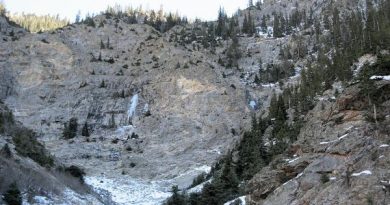Colorado cities struggle to keep up with road work, maintenance
Littleton was poised to get to work on a $10 million project to relieve congestion at one of its most troublesome intersections. Then the pandemic hit — upending government budgets across the state.
Now officials in the south metro Denver city are scrounging to find about $2 million to fulfill the local contribution required for a federal grant on the project, which would build a reliever road to route some traffic away from the Santa Fe Drive and West Mineral Avenue intersection. Money is tighter for some other projects, too.
“The picture wasn’t particularly rosy before COVID,” said Keith Reester, Littleton’s director of public works and utilities, with longstanding challenges facing the city’s capital projects fund. “Now we’re kind of in a waiting period to see what happens for a bit, as we plan for the future.”
The financial hit from the pandemic has forced cities and towns across the state to put off projects, cut back on investments in their infrastructure or defer more maintenance to better economic times. In a recent survey organized by the Colorado Municipal League, the most common fiscal challenges expected by local officials in 2021 included unfunded street maintenance and improvements as well as waterworks projects.
The dynamic is playing out in varying ways, according to interviews with local officials in several regions of the state. In Denver, city leaders decided to accelerate projects from a huge multiyear bond package, which is insulated from the downturn. But declining tax revenue has forced trims for regular capital programs, including road resurfacing, and for annual maintenance programs.
In Fort Collins, city officials worry about getting too far behind on maintenance, facility upgrades and replacement of aging city vehicles.
And in Breckenridge, wildly fluctuating tax revenue last year has prompted caution — a common posture in tourism-heavy mountain towns, many of which drew normal summer crowds while other months rated among their worst ever. Breckenridge has a major parking garage project underway downtown, but town officials have put accompanying streetscape upgrades, including signage and heated walkways, on hold until they see how the ski season pans out.
Littleton has a potential relief valve on the horizon. Its voters last fall allowed the start of recreational marijuana sales, and City Manager Mark Relph says the resulting tax money could fill the gap for some projects or help keep the city vehicle fleet up to date. But with competing priorities, that decision hasn’t been made yet.
Protecting services came at a cost
When shut-down orders last March stanched the flow of tax revenue to cities and towns across the state, local officials feared the worst. They went to work slashing their operating budgets and put off some capital projects, too — preparing for the biggest economic hit since the Great Recession.
Though their worst fears didn’t come to pass, significant budget challenges arose.
In many cases, cities were able to ease up on employee furloughs and cuts, aided in part by federal relief money that also enabled community aid programs. The loosening of public health restrictions during the summer allowed for more normal economic activity — though restrictions tightened again in some parts of the state, including metro Denver, when coronavirus cases skyrocketed in the fall.
“With how scared we were, we’ve done much better than we expected,” said Heather Brooks, the city manager for Alamosa in southern Colorado’s agriculture-rich San Luis Valley.
But Kevin Bommer, the Colorado Municipal League’s executive director, said the results from the group’s annual survey, released Jan. 19, show that resiliency is reflected more in cities’ operating budgets than in the capital funds that cover projects and maintenance. He noted that many local governments already had extensive backlogs of deferred maintenance and infrastructure projects, thanks in part to the lingering effects of the Great Recession.
“What that tells me is that municipalities rallied to protect core services,” Bommer said, which meant prioritizing workers’ salaries. “They did everything they could to keep the people providing services — and then made decisions about paying for projects.”
That’s in keeping with cities’ and towns’ priorities during past downturns.
The CML has 270 cities and towns as members, and 173 — nearly two-thirds — participated in the survey through early fall, as they were crafting their 2021 budgets.
Among the findings:
- 36% of cities and towns that responded cut back spending on capital improvements during 2020, and another 13% were considering the move at the time of the survey.
- Heading into 2021, 78% expected unfunded street and road maintenance and other improvement needs to be a fiscal challenge, making it the most common concern. Thirty-five percent rated this as a major challenge.
- 68% said unfunded water and wastewater utility improvement needs would be a challenge in 2021, including 28% that rated it as a major challenge. This was the third most common concern, behind the lack of affordable housing, which came in second at 76%.
Cities also consider impact of projects
Fort Collins city officials share some of those worries, though they have some insulation — their annual capital program has been buoyed by its own dedicated sales tax, safeguarding many projects.
But the city delayed work on major portions of one prominent project, a $3.5 million rehab of Linden Street in its Old Town area that aims to make it more pedestrian-oriented. City Manager Darin Atteberry and Travis Storin, the city’s chief financial officer, said shops and restaurants in the area still were reeling from pandemic restrictions.
“Had we started it, it would’ve slammed a lot of businesses right during the holiday season,” Storin said.
It might not be the right time for such a disruptive project for another year or more, Atteberry said.
In the state’s largest city, the bottom line looks downright optimistic — Denver’s 2021 budget calls for $482.6 million in spending on capital improvements, up more than $20 million over last year.
But that reflects efforts made by city officials to offset declining revenue and the end of an annual transfer from the general fund to support projects. Julie Smith, a spokeswoman for Denver’s finance department, said city officials decided to add $100 million to supercharge what would have been a $70 million bond issuance. It’s the latest phase of the $937 million Elevate Denver bond program that is paying for a raft of specific projects across the city.
The city capitalized on low interest rates, she said, and considers the extra spending, which would’ve happened in coming years anyway, a local stimulus program.
Also on a strong footing overall is Grand Junction, the Western Slope’s most populous city. That city’s leaders also credit a bond program approved by its voters prior to the pandemic.
The city budget has recovered quicker than most, due in part to Mesa County’s looser public health restrictions compared to other large counties during much of the pandemic, allowing businesses to operate more normally. The bond program raised $50 million last year, with many projects getting underway this year as part of Grand Junction’s $85 million budget for capital projects.
“It’s the largest capital expenditure budget in a number of years, and maybe even ever,” City Manager Greg Caton said.
Still, the construction industry is watching municipal-level spending warily across Colorado.
Roughly a third of the workload in Colorado comes from projects initiated by local governments, according to the Colorado Contractors Association, which says it’s bracing for a moderate downturn in spending on road, bridge, transit and other non-building projects this year.
But that will depend heavily on whether Congress approves a third round of COVID relief with aid for state and local governments — a prospect also being watched by city officials in Littleton, Fort Collins and other cities that might benefit. Separately, state officials are discussing proposals for more spending on highway projects, some of which may seep down to local projects.
“We’re definitely bracing for a bit of a downturn in 2021 due to the pandemic,” said Tony Milo, the association’s executive director. ” At the same time, we are hopeful that due to some help from the federal government and work by our governor and our General Assembly, we can cobble together some additional infrastructure money … and keep the economy moving forward.”
Source: Read Full Article



